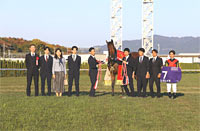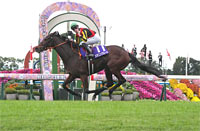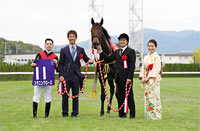Queen Elizabeth II Cup (G1) - Data Analysis
Top contest for fillies/mares to be held at Hanshin Racecourse
This year’s Queen Elizabeth II Cup will be held at Hanshin Racecourse as Kyoto Racecourse, its typical venue, is undergoing maintenance work. After winning the race in 2018, Lys Gracieux went on to secure victories in three domestic/overseas G1 races (the Takarazuka Kinen, the Cox Plate, and the Arima Kinen (the Grand Prix)), and subsequently won the JRA Award for Horse of the Year. These events are still fresh in our memory. Meanwhile 2019 winner Lucky Lilac dominated this year’s Osaka Hai. In other words, Queen Elizabeth II Cup winners have in recent years performed well in subsequent G1 races open to both fillies and colts. Let’s now analyze results over the last 10 years, focusing on horse age and other factors likely to be little affected by the change in venue.
Focus on younger horses
Looking at performances by runners over the last 10 years in terms of age, we find that 4-year-olds have won the race six times. The two winners mentioned in our introduction, Lys Gracieux and Lucky Lilac, similarly were 4 years old. Meanwhile, 3-year-olds achieved the highest Top 2 and Top 3 ratios. Together, 3-year-olds and 4-year-olds accounted for 25 of the 30 Top 3 finishers. [Table 1]
[Table 1] Performance by age (10 years)
| Age |
Performance
[1st-2nd-3rd-4th or lower] |
Win ratio |
Top 2 ratio |
Top 3 ratio |
| 3 |
3-4-3-29 |
7.7% |
17.9% |
25.6% |
| 4 |
6-3-6-45 |
10.0% |
15.0% |
25.0% |
| 5 |
1-2-1-48 |
1.9% |
5.8% |
7.7% |
| 6 |
0-1-0-14 |
0% |
6.7% |
6.7% |
| 7 and above |
0-0-0-7 |
0% |
0% |
0% |
In addition, all of the five horses aged 5 and above that entered the Top 3 had finished in the Top 5 of the Queen Elizabeth II Cup of the previous year. Horses aged 5 and above with this record also achieved an excellent Top 3 ratio of 38.5%. Even though the race venue this year has changed from Kyoto Racecourse to Hanshin Racecourse, we should raise our expectations of runners that have performed well in the 2019 Queen Elizabeth II Cup. [Table 2]
[Table 2] Among horses aged 5 and above, performance by finish in Queen Elizabeth II Cup of previous year (last 10 years)
| Finish |
Performance
[1st-2nd-3rd-4th or lower] |
Win ratio |
Top 2 ratio |
Top 3 ratio |
| Top 5 |
1-3-1-8 |
7.7% |
30.8% |
38.5% |
| 6th or lower, or did not run |
0-0-0-61 |
0% |
0% |
0% |
Strong performance by runners coming straight from a G1 or G2 race
Looking at performances by runners over the last 10 years in terms of their previous race, we observe that the few runners that had come straight from the All Comers achieved favorable Win and Top 2 ratios of 33.3% and 50.0%, respectively. Runners that had come straight from the Fuchu Himba Stakes (G2) produced the highest number of Top 3 finishers. Among such runners, Sing with Joy finished as runner-up in the 2016 race despite being backed as 12th favorite, and Crocosmia similarly finished as runner-up in the three consecutive races from 2017 to 2019 despite being backed as 7th favorite or lower in each of these races. In other words, we should not underestimate runners coming from the Fuchu Himba Stakes, even if they are poorly favored. In addition, among 3-year-olds that finished in the Top 3 of the Queen Elizabeth II Cup, seven out of 10 had previously contested the Shuka Sho. We should therefore regard the All Comers, the Fuchu Himba Stakes, and the Shuka Sho as important warmup races. [Table 3]
[Table 3] Performance by previous race (last 10 years)
| Previous race |
Performance
[1st-2nd-3rd-4th or lower] |
Win ratio |
Top 2 ratio |
Top 3 ratio |
| Shuka Sho (G1) |
2-3-2-20 |
7.4% |
18.5% |
25.9% |
| Fuchu Himba Stakes (G2) |
4-4-3-45 |
7.1% |
14.3% |
19.6% |
| All Comers (G2) |
2-1-0-3 |
33.3% |
50.0% |
50.0% |
| JRA graded race other than the above |
0-1-4-33 |
0% |
2.6% |
13.2% |
| Open-class race |
0-0-0-12 |
0% |
0% |
0% |
| Allowance-class race |
0-1-1-28 |
0% |
3.3% |
6.7% |
| Overseas race |
2-0-0-2 |
50.0% |
50.0% |
50.0% |
Note: The Fuchu Himba Stakes (G2) was held as a G3 race in 2010. This race is included in “JRA graded races other than the above.”
Note: Runners that contested a foreign race last time out were all foreign horses.
Lackluster performance by runners that had finished 6th or lower in their previous race
Looking at performances by finish in the previous race, we observe that 26 of the 30 Top 3 finishers over the last 10 years had finished in the Top 5 of their previous race. This included Rainbow Dahlia, who won the 2012 Queen Elizabeth II Cup while backed as 7th favorite (previous race was Fuchu Himba Stakes, finished 4th), and Marialite, who won the 2015 Queen Elizabeth II Cup while backed as 6th favorite (previous race was All Comers, finished 5th). Among runners that had finished 6th-9th in their previous race, Sing with Joy (previous race was Fuchu Himba Stakes, finished 7th) achieved the highest position in the Queen Elizabeth II Cup, finishing as the runner-up in 2016. Among runners that had been beaten to 10th or lower in their previous race, performance was even worse, with Apapane being the only runner to finish in the Top 3 in 2011 (previous race was Fuchu Himba Stakes, finished 14th). In other words, among runners coming straight from the warmup races discussed above, we should lower our expectations of runners that have finished 6th or lower in that race. [Table 4]
[Table 4] Performance by finish in previous race (last 10 years)
| Finish in previous race |
Performance
[1st-2nd-3rd-4th or lower] |
Win ratio |
Top 2 ratio |
Top 3 ratio |
| 1st |
2-4-4-35 |
4.4% |
13.3% |
22.2% |
| 2nd |
2-3-1-18 |
8.3% |
20.8% |
25.0% |
| 3rd |
3-0-2-13 |
16.7% |
16.7% |
27.8% |
| 4th |
2-0-0-12 |
14.3% |
14.3% |
14.3% |
| 5th |
1-2-0-7 |
10.0% |
30.0% |
30.0% |
| 6th-9th |
0-1-2-30 |
0% |
3.0% |
9.1% |
| 10th or lower |
0-0-1-28 |
0% |
0% |
3.4% |
Focus on runners with experience of finishing in Top 2 of G1 race
Looking at performances by runners over the last 10 years in terms of experience of finishing in the Top 2 of a JRA or overseas G1 race, we note that 20 of the 30 Top 3 finishers had such experience. Three of the five runners with such experience finished in the Top 3 in 2018, and three of the four runners with such experience occupied the Top 3 in 2019. [Table 5]
[Table 5] Performance by experience of finishing in Top 2 of JRA or overseas G1 race (last 10 years)
| Experience |
Performance
[1st-2nd-3rd-4th or lower] |
Win ratio |
Top 2 ratio |
Top 3 ratio |
| Yes |
8-6-6-45 |
12.3% |
21.5% |
30.8% |
| No |
2-4-4-98 |
1.9% |
5.6% |
9.3% |
Seek out the winner!
Check record in middle-distance graded races
The last seven winners of the Queen Elizabeth II Cup were all aged 4 or below, had contested their previous race in the Shuka Sho, Fuchu Himba Stakes, or the All Comers, and finished in the Top 5 of that race. In other words, they matched the age trend shown in [Table 1] and the trends related to the previous race shown in [Table 3] and [Table 4]. Other features shared by the seven recent winners were that they had finished in the Top 2 of a 1,800-2,200m JRA graded turf race held in the same year. This suggests that the track record in middle-distance races is also an important factor we should consider when attempting to predict the winner. [Table 6]
[Table 6] Winners’ age, previous race, and 1,800-2,200m JRA graded turf race held in same year with Top 2 finish (last 7 years)
| Year |
Winner |
Age |
Previous race |
1,800-2,200m JRA graded turf race held in the same year with Top 2 finish |
| 2013 |
Meisho Mambo |
3 |
Shuka Sho, 1st |
Shuka Sho, 1st |
| 2014 |
Lachesis |
4 |
All Comers, 2nd |
All Comers, 2nd, etc. |
| 2015 |
Marialite |
4 |
All Comers, 5th |
Mermaid Stakes, 2nd |
| 2016 |
Queens Ring |
4 |
Fuchu Himba Stakes, 1st |
Fuchu Himba Stakes, 1st |
| 2017 |
Mozu Katchan |
3 |
Shuka Sho, 3rd |
Flora Stakes, 1st |
| 2018 |
Lys Gracieux |
4 |
Fuchu Himba Stakes, 2nd |
Fuchu Himba Stakes, 2nd |
| 2019 |
Lucky Lilac |
4 |
Fuchu Himba Stakes, 3rd |
Nakayama Kinen, 2nd |
(Maya Takanami)
|

- Preview
- Barrier draw
- Past performances of runners

- News
- Race result
- Video
- 2025 English

- 2024 English

- 2023 English

- 2022 English

- 2021 English

- 2020 English

- 2019 English

- 2018 English

- 2017 English

- 2016 English

- 2015 English

- 2014 English

- 2013 English

- Photo Gallery
2025 Winner: Regaleira


2024 Winner: Stunning Rose


|


















